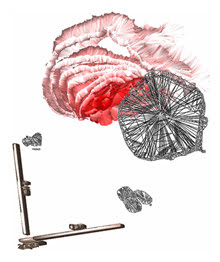DUSSELDORF, Germany, March 1, 2006 -- Researchers in the Department of Microstructure Physics and Metal Forming at the Max Planck Institute for Iron Research in Dusseldorf have created what they say is the world's first electron microscope that allows scientists to determine the phase content, crystallographic texture and crystal interfaces of nanomaterials in a way no other microscopic procedures can -- fully three dimensionally.
Integrated into the device is a high-resolution scanning electron microscope and an ion beam microscope, two instruments that until now have been used separately. It also contains a number of detectors which can measure electron diffraction patterns and orientations, as well as perform chemical analyses. This allows scientists to see the inner structure of nanomaterials, biological matter and high-performance steels in 3-D.

An image of the 3-D gradient of the crystallographic orientations in an intermetallic iron-aluminium specimen (lattice curvature) close to a very hard Laves phase (appears as a transparent net) that can be taken with the Max Planck Institute for Iron Research's new electron microscope. The various layers of color indicate increasing changes in the crystal orientation from the reference point directly at the interface between matrix and Laves phase in two-degree misorientation intervals. (Image: Max Planck Institute for Iron Research)
The chance to investigate microstructures three-dimensionally is of great use to materials scientists, and until now, there have only been a few ways to do it, primarily by using either x-rays, electron beams or neutron beams. The advantages of these methods are that they are not destructive and let scientists reconstruct the 3-D structure. But this process is also time-consuming and provides only limited information, particularly for crystalline materials. Also, the lateral resolution is about two orders of magnitude below that of the new 3-D approach the Max Planck scientists have unveiled, which reaches at least 40 cubic nm.
Another option has been to take an image of the material in slices, and then reconstruct it tomographically in three dimensions. The new microscope makes 3-D images by first taking a two-dimensional picture using the desired crystallographic or chemical method. Then, with nanoscopic precision, an ion beam slices off a piece of the material, and the layer underneath can be analyzed. The researcher can then investigate the material slice for slice, and in the end, the device produces a digital 3-D image.
The microscope functions fully automatically, allowing relatively large areas to be investigated. For example, volumes of 70 x 70 x 70 µm. The scientists said the powerful combination of automatically slicing off material and looking at it in high resolution produces a range of crystallographic information much broader than most other microscopy techniques. That information includes the exact form of the embedded crystals, the position and crystallographic characteristics of internal interfaces, the density of defects in grains and very fine textural details. All these characteristics can be measured at a lateral resolution of about 40 cubic nm, and depending on the material, even more finely.
Max Planck scientists working with professor Dierk Raabe and Stefan Zaefferer, coauthors of a paper about the research, have already looked at steel-related iron-aluminium intermetallic alloys. These alloys are characteristically highly resistant to oxidation and sulphidation at high temperatures, but they are not completely hard and homogeneous. For this reason, the scientists are adding tiny particles and chromium in an attempt to refine the materials for technical application. Such alloys could be used in newly designed high-temperature gas turbines for conventional power plants, allowing the plants to operate more efficiently and ecologically and bring down energy costs.
In the case of the iron-aluminium intermetallic alloy, Raabe and his colleagues are using the instrument to look at the effect of embedded particles on the microstructure and macroscopic characteristics of the material. In particular, the scientists investigated how tiny inclusions in the intermetallic matrix influence the orientation of the alloy’s crystal lattice.
This project was supported by the Max Planck Society and the German Research Foundation. For more information, visit: www.mpg.de/english